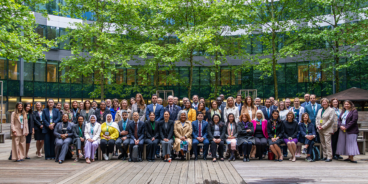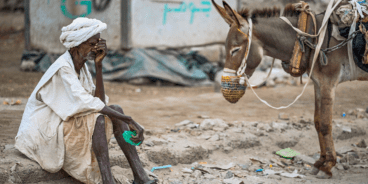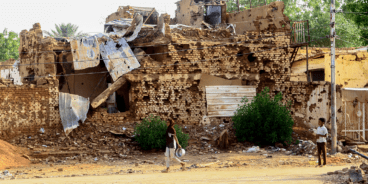The Responsibility to Protect in the Americas
Remarks delivered by Dr. Simon Adams, Executive Director of the Global Centre for the Responsibility to Protect, on 21 March 2019 in Washington DC at an event hosted by the General Secretariat of the Organization of American States in partnership with the Stanley Foundation.
It is an honour for me to be here today and contribute to the discussion on the Responsibility to Protect (R2P) in the Americas. I would like to thank the Organization of American States (OAS) and the Stanley Foundation for the invitation.
At the heart of R2P is the principle that states must act to prevent mass atrocity crimes and protect all populations from the threat of these crimes. But how to implement and uphold that responsibility? And how should I talk about that multifaceted and complex process in just five minutes?
I want to start by mentioning that one of the first human rights protests I ever attended was in the 1980s in Australia, against the military dictatorship in Chile. I mention this because I think it is worth recalling that it was military rule that was the dominant form of government across much of the continent in the 1970s, with Brazil, Argentina, Peru and Chile all being cases in point. The common view around the world was also that Latin America was a zone of conflict, with ongoing bitter and bloody civil wars in El Salvador, Nicaragua and Guatemala during the 1980s.
It is astonishing that such a dramatic political change took place in South and Central America from the late 1980s onwards until almost all states on the continent became democracies and even the most debilitating armed conflicts were resolved. Latin America became, as its diplomats at the UN in New York liked to point out, “a zone of peace.” Latin America also became a zone of “norm entrepreneurship.” Latin America played a crucial role in advancing international justice through the founding of the International Criminal Court (ICC) and became leaders in upholding the principle of R2P.
More broadly, one OAS member state, Canada, deserves special mention as being the veritable inventor of R2P in 2001. It also played a crucial role in establishing the ICC and became the first country in the world to adopt comprehensive legislation incorporating the Rome Statute. I mention this because international justice is not only punitive, it is preventive. In fact, the example of Latin America demonstrates that accountability should be seen as more than simply criminal prosecutions, but rather as incorporating truth, justice, as well as rebuilding and potentially reconciliation.
In Argentina, the National Commission on the Disappeared provided important recommendations on how to reform the legal system in order to ensure stronger adherence to human rights norms. The information collected by the Commission was also crucial in the trials of the former military junta. In Chile, the Truth and Reconciliation Commission put forward a strategy to ensure greater harmonization of national laws with international human rights obligations. In Colombia, the Commission for the Clarification of Truth, Coexistence and Non-Repetition forms part of a much broader transitional justice strategy, including the Special Jurisdiction for Peace Tribunal, which will prosecute those responsible for war crimes.
In short, institutions that strengthen human rights and accountability are an essential part of how we build resilient societies. They are also an essential part of what binds us, and defines us, as an international community. And they are at the heart of the implementation of R2P in the Americas.
THE CRISES IN VENEZUELA AND NICARAGUA
But let me highlight that the reverse is also true. Impunity begets impunity. And we are living through a period where human rights norms and institutions are now under increasing attack globally. While it would be wonderful to be able to both begin and end my short intervention by sharing positive examples of the effective implementation of R2P ideas, policies and strategies across the Americas, we are unfortunately also reminded of how quickly the erosion of human rights can reverse decades of progress.
We see that even here in the United States, there has been a rise of anti-refugee policies, and of anti-Muslim hate speech, with the government unfortunately withdrawing from the UN Human Rights Council and retreating from multilateralism. And I’m not even going to talk about that useless and insulting wall.
Another particularly worrying example is Brazil, where last year saw the election of a president who publicly declared that he was “in favor of torture” and praised the past military dictatorship. This should serve as a serious warning sign.
I would also like to emphasize two country situations in Latin America that have, in a relatively short period of time, moved to the core of GCR2P’s work in New York and Geneva. In Nicaragua, ongoing and intensified repression by state authorities has triggered a severe human rights crisis in the country, and the Interdisciplinary Group of Independent Experts, mandated by the Inter-American Commission on Human Rights, reported that possible crimes against humanity have been committed between April-May 2018. This finding has also been echoed by the UN High Commissioner for Human Rights.
Which brings us, finally, to the ongoing political conflict and systematic human rights violations in Venezuela. It was the independent experts mandated by OAS who, in May 2018, warned that the government has committed crimes against humanity over the past four years, including more than 8,000 extrajudicial killings and the arbitrary detention of more than 12,000 individuals. We strongly believe that the current battle over political power and recognition; the militarization of pro-government militias (including so-called colectivos); the politicisation of humanitarian aid; and the deep divide between the government and the opposition, all increase the risk of escalating political violence. There is a particular threat that the military may increase violence against the civilian population in a way that grievously violates international law.
R2P AND MILITARY INTERVENTION
So what is to be done? First of all let me emphasize what should not be done. R2P does not permit unilateral military intervention outside of international law. While it is true that R2P includes the potential use of military force as a matter of last resort, R2P is fundamentally about deploying force in ways that are both legitimate and legal. Nor is R2P a tool for regime change. And at this stage, despite unilateral threats from the hemisphere’s major superpower, the United States, there is no consensus at the UN Security Council, at the OAS, or in the region that the situation in Venezuela would justify military intervention. Besides the question of legality, there is also a serious “balance of consequences” argument to be made with regard to any proposed military intervention in Venezuela.
But the choice is not between invasion or inaction. Instead we strongly support the regional referral to the International Criminal Court – the first such situation to be referred to the ICC by a group of states for crimes that have taken place in another state. And we think there is a need to continue to increase the pressure on the Venezuelan government – through escalating targeted sanctions; through expanding an arms embargo; through investigating and documenting
potential crimes against humanity; and by supporting the diplomatic efforts of the 14 states of the Lima Group to end the abuses of the Maduro government. We need more high-level diplomatic intervention.
But the message should be that those who are responsible for mobilising colectivos, for torture and arbitrary detention, for extrajudicial killings, and potential crimes against humanity, must be held accountable under-international law. The question should not be “if,” but “when.”
The Nicaragua case is different in intensity and longevity, but time forbids me from making more than the general point that I believe that the UN Human Rights Council could potentially play an important role. Right before I got on stage a few minutes ago I received a text saying that the Council had just passed its first resolution on the terrible situation in Nicaragua. I hope it will be the start of a process of the international community holding the government to account for its actions. A beginning, not an end.
THE AMERICAN WAY?
In conclusion, American states have led the way in the transition from dictatorship to democracy and from being human rights abusers to becoming champions of the human rights norms and institutions that safeguard humanity. The lesson of Latin American history is that no government that systematically tortures people and systematically abuses human rights can long endure. Our job is to help end that suffering and ensure that all governments in the Americas uphold their responsibility to protect their populations, without exception.
Thank you.
Further comments in response to a question about potential military intervention in Venezuela as a matter of “last resort”:
I think there are questions we should all ask ourselves regarding when and how the use of force is both legal and legitimate. A lot hinges on what the region says, what the states in the region determine, and of course, whether the UN Security Council endorses such action. Overall, I think that whenever we discuss the use of force in any country there are prudential criteria that we should be considering, and five questions that the international community should be asking itself.
1. What is the seriousness of the threat? In the case of Venezuela, is this a situation where there is a genuine threat of mass atrocity crimes?
2. What is the proper purpose of any use of force or possible military intervention? Is the purpose simply regime change, or is it to protect people’s lives from mass atrocities? We need to secure that proper purpose.
3. Are there the proportional means to carry out any military intervention? The means must be appropriate and proportional to the threat.
4. Is this a matter of last resort? Has everything else been tried, within reason, to resolve the situation diplomatically – through mediation, through sanctions, through an arms embargo and other collaborative and coercive measures?
5. What is the balance of consequences? This, in particular, is a very difficult question when looking at the case in Venezuela. Would the use of force make the situation better, or could it conceivably make the situation much worse? Foreign military intervention could potentially worsen the humanitarian crisis in the country.
It is impossible to answer all these questions with absolute certainty, but anybody who is seriously debating the possibility of military intervention in Venezuela or anywhere else in the world should be running through those considerations. Because I think part of the problem is that all too often these matters come down to people asking whether you are for regime change or not? As my friend Ed Luck, the former UN Special Advisor for R2P, used to say,
I’m for regimes changing their behavior. And in the case of Nicaragua and Venezuela, these are states that desperately need to change their behavior regarding human rights.
The only side to be on in Venezuela and Nicaragua is on the side of people who are facing systematic human rights abuses and whose lives are at stake. But military intervention should not be the only answer to this problem. This is why I say it is not a choice between invasion and inaction. The question is what are you going to do – right now, today – to help ensure the governments of Venezuela and Nicaragua uphold their responsibility to protect? This is a question that every state in the region, the UN, the international community, and everybody in this room, should be asking themselves.
Read Next
Related Publications

11th Meeting of the Global Network of R2P Focal Points Outcome Document

Atrocity Alert No. 443: Sudan, Israel and the Occupied Palestinian Territory and United States Travel Ban
